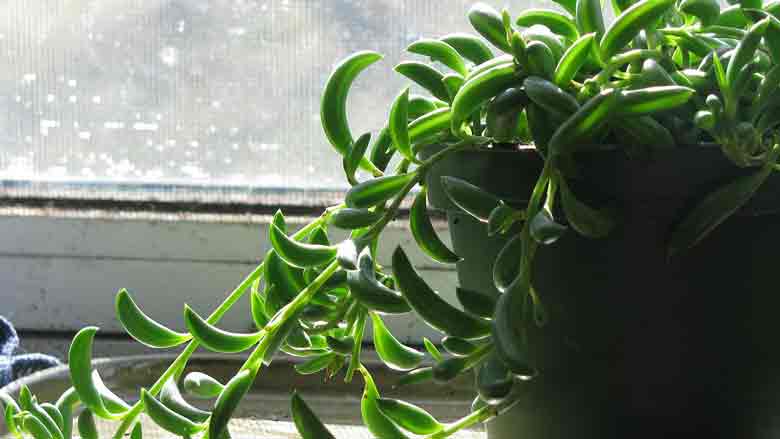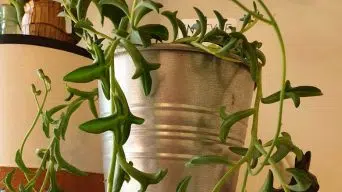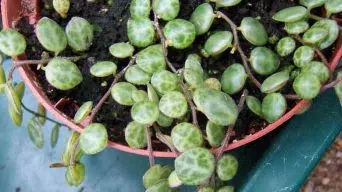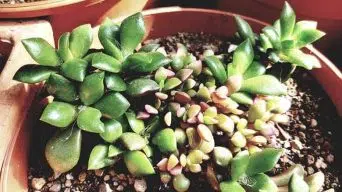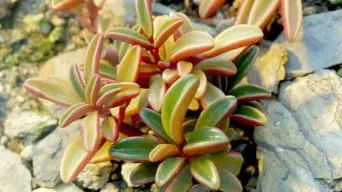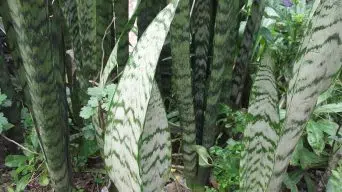Growing succulents is pretty effortless, but there are some things you need to know about how to take care of your succulents.
Succulents are plants that have adapted to survive in arid climates by storing water in their fleshy leaves, stems, or roots.
One succulent that is particularly easy to grow is the Curio radicans, also known as String of Bananas.
This plant has become very popular because it is so easy to grow, but you still need to know how to take care of your Curio radicans.
This article will go over everything you need to know about taking care of and propagating String of Bananas.
Overview
Curio radicans, formerly known as Senecio radicans, is a hanging succulent plant from the family Asteraceae native to South Africa.
The Curio radicans succulent is a plant with banana-shaped leaves on its stems. The leaves are fleshy and green and can grow up to 1.2 inches (3 cm) long.
The mat-forming stems may grow up to 3 feet long (90 cm), making it an excellent ground cover as well as a terrific cascading over the edges of planters or hanging baskets.
Tiny white flowers with a cinnamon scent are usually seen in late winter or early spring.
The Curio radicans is commonly known as String of Bananas, but it is also known as:
- Banana Vine
- Creeping Berry
- Fishhook Senecio
- Necklace Plant
- String of Fishhooks
- String of Pearls
How To Care for Curio Radicans (String of Bananas)
String of Bananas care and propagation is easy and very rewarding.
With just a little bit of knowledge and time, anyone can have their own thriving Curio Radicans plant, which will produce more String of Bananas plants throughout the years.
Below you’ll find the essential information you need to know about caring for Curio radicans (String of Bananas).
Sun Exposure & Light Requirements
The String of Bananas plants only requires bright light to thrive indoors. The plant should not be placed in direct sunlight.
The ideal location would be next to a window where the plant receives bright indirect sunlight.
The plant can survive in low light but suffer from poor growth and development if not placed in bright light.
A west-facing or east-facing window will be ideal if the String of Bananas is grown indoors.
West-facing windows will give the plant bright morning sunlight, encouraging active growth.
East-facing windows will also provide ample indirect sunlight during the day, but it will typically not get direct sun at all.
If grown outdoors, the String of Bananas should be placed in a location with partial shade. This will ensure the plant gets enough sunlight for photosynthesis but will also be protected from harsh direct sun rays.
It needs to be placed where there is no direct sunlight during the hottest part of the day because the leaves may sunburn if left in direct sunlight for too long.
Watering Requirements
The String of Bananas needs to be watered every one to two weeks in the summer and once every three to four weeks during winter.
Ensure there is good drainage in the container so that their roots are not sitting in water.
Overwatering can produce soft stems which will decay, but underwatering will cause wilting of leaves.
These plants only need to be watered when the soil is completely dry, which you should check by sticking your finger down into the pot’s soil.
The amount of water needed varies depending on many factors such as humidity, sunlight, container size, etc., but generally speaking, watering once or twice a week will suffice.
Soil Requirements
The String of Bananas plant likes to grow in well-draining soil. The best option for this is to use a succulent or cactus soil mix.
This type of soil is a soil-less substrate that is cactus and succulent friendly.
It contains ingredients that ensure proper drainage, airflow, and water retention capability. Also, it is chemical-free and does not contain any fertilizers or pesticides.
If you want to make your own soil mix, you can use regular potting soil mixed with coarse sand and perlite.
Make sure to add enough coarse sand and perlite so that the soil isn’t heavy when wet.
The greater the airflow, the better since the Curio radicans (String of Bananas) succulent plant tends to dry out quickly and does not like having its roots in water.
Temperature and Humidity
Curio radicans (String of Bananas) is an easy-to-care-for plant that does best in an environment with warm temperatures and low humidity.
Temperatures below 60 degrees Fahrenheit are harmful to this plant, while temperatures above 80 degrees can cause damage to leaves or even kill the plant.
A good room temperature is between 70 and 80 degrees, with around 40% relative humidity.
Fertilizing
String of Bananas plants don’t need fertilizing often. If you fertilize too often, they can get sick and die.
They only need to be fertilized during the growing season, which is spring and summer.
You should fertilize them once every one or two months with a balanced liquid fertilizer diluted to half-strength.
Like most succulents, Curio radicans (String of Bananas) is sensitive to chemical fertilizers, so organic is always better.
Potting and Repotting
String of Bananas is a mat-forming succulent that can grow very long, great for hanging baskets or spilling over the front of a container.
It spreads wide, rooting down along the stems wherever nodes touch the ground. Curio radicans can remain small if grown in a small pot, but it has the potential to become invasive.
When grown in pots, ensure that the container has several drainage holes, as Curio will easily rot if kept wet for too long.
Curio does not need to be repotted often, but spring is the best time when it is necessary and if the plant has reached its desired size (which may take a few years).
To repot Curio radicans, prepare a well-draining succulent or cacti mix soil and fill your container about halfway.
Remove the String of Bananas from its current pot and gently shake the soil from its roots.
Place your plant in the center of the new container, spreading out the roots a little to find where they comfortably fit inside.
Fill about an inch or two around it with soil, making sure not to leave any air pockets.
Curio radicans will spread to form a ground cover when grown in the ground. It is essential only to plant the String of Bananas where it has plenty of room to spread out.
Pruning
The String of Bananas is a trailing succulent that tends to trail over the soil surface and quickly produce aerial roots.
This succulent is noted for its fast growth rate and can grow quite long.
Pruning is often necessary as one of the most common issues with this plant is its tendency to grow out of control.
However, it can be pretty versatile, and growers have noted that they’ve seen the Curio radicans succulent use aerial roots to ‘climb’ on rocks or even up a wall if given enough time.
The best time for pruning is in the early summer before the next growing season starts.
Pruning should consist of snipping off the larger growths with clean shears.
If you want to reduce the size of your Curio radicans, try snipping off the tips rather than removing the entire growth. This will encourage more dense growth at the end of each stem.
Any pruning should not make the total amount of stem less than 1/3 of the original size (especially for mature Curio radicans).
If you keep this in mind while trimming your String of Bananas houseplant, it will be much healthier, and you won’t have to worry about its growth rate slowing down.
Pests and Diseases
The String of Bananas Plant is not prone to pests and diseases, but it doesn’t mean it can’t be bothered with them.
Some common pests and diseases that can plague Curio radicans plants are mealybugs, aphids, and rot.
Mealybugs
Mealybugs are very common pests that plague succulents.
They look like white cotton candy stuck on the plant.
To get rid of them, use cotton swabs dipped in alcohol to rub off the mealybugs.
Aphids
Aphids look like greenish/grey dots on the String of Bananas succulent plant.
They are most commonly found underneath the leaves (where they lay their eggs).
Use neem oil or cotton swabs soaked in alcohol to get rid of aphids.
Rot
When rotted, the String of Bananas will start turning brown.
Cut the rotted portion off and keep it well-ventilated and dry until new green growths appear.
Do not overwater as this may promote rotting. Rotting can also be caused by too much or too little sunlight, so be sure to check if that’s the case.
If it is, move the plant to a place with less direct sunlight.
How to Care for Curio Radicans (String of Bananas) in Winter
Curio radicans care in winter is more difficult than in summer.
The String of Bananas is not a cold-hardy succulent plant, which means that during colder months, it will be susceptible to damage from frosts and freezes.
However, there are some steps you can take to ensure your plant thrives during the cold months.
- Bring it inside when the temperatures begin to drop.
- Water it less frequently, as the plant does not require much water in winter.
- Let the soil completely dry out between waterings to prevent decay from taking hold. There is a good chance that disease will take root if you allow the succulent plant to remain wet for an extended period.
- Provide a brighter area away from direct sunlight–preferably a western-facing window for bright indirect light.
- Ensure the temperature is between 55 and 75 degrees Fahrenheit (13 – 24 degrees Celsius).
- Stop fertilizing during the winter months.
- Reduce or stop repotting your plant in winter if you do so regularly.
- Consider pruning back Curio radicans leaves in winter to conserve energy.
- Rotate the plant weekly to ensure even, continued growth.
Winter care is critical if you have a String of Bananas planted outdoors.
Since this is the time when heavy nighttime frosts tend to occur, your succulents must be brought indoors before a frost or freeze occurs.
How To Propagate String of Bananas (Curio Radicans)
The String of Bananas (Curio radicans) is a type of succulent plant that is very easy to propagate.
It can be easily propagated from stem cuttings. Here is a step-by-step guide for propagating the String of Bananas:
- Choose a healthy plant to start with. The parent plant should have several stems.
- Remove stems from the parent plant. Use a pruning tool to cut through the stems just below where there are leaves attached. The more stems you cut, the more new plants you will have.
- Lay your stem cutting horizontally and let it dry for a few days to form a callus over the spot where you cut it from the parent plant.
- Fill a pot with commercial cacti/succulent potting mix, or make your own mixture of sand and soil. Ensure the soil is well-draining since String of Bananas is a succulent plant and does not like soggy soil.
- Plant the callused end of the cutting into the soil and gently push it in.
- Water the String of Bananas sparingly at first to avoid rotting, but ensure there is always some water at the roots so the soil does not dry out completely.
- Move the planted cutting to a sunny location, preferably with morning sun and afternoon shade.
- After about 2-3 weeks, you should begin to see new leaves sprouting from your String of Bananas cutting.
- Once the new plant is established, you can begin to water more generously, but only when the top of the soil has dried out.
- As your String of Bananas grows, it is time to repot the plant. Increase the pot size gradually over several weeks so that you can give your new succulent plenty of room to grow.
Enjoy your new plant!
Final Thoughts
Growing succulents is easy, and String of Bananas is no exception.
Like all succulents, if kept in the right conditions provides you with an effortless way to add some greenery to your life.
They are hard to kill and require very little maintenance. If you take care of them, they can last for years with proper care!

